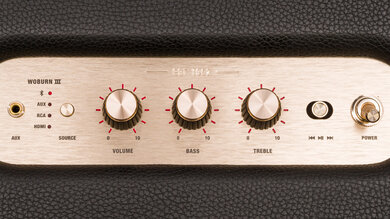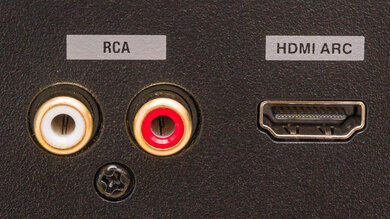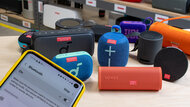The Marshall Woburn III is a wired home speaker that boasts the company's signature retro-style design. It stands out from other speakers on the market thanks to its RCA and HDMI ARC inputs, which make it easy to integrate with other components in your living room, like your TV. Features like its placement compensation tool are designed to bring you the best possible sound, adjusting the device's output depending on where it's set up in your room. It's on the higher end of the manufacturer's home audio lineup than models like the Marshall Acton III and the Marshall Stanmore III.
Our Verdict
The Marshall Woburn 3 is very good for music. It comes with many features to optimize your listening experience, including a placement compensation tool in the app. It lets you input the position of the speaker in your living room, whether it's near a wall or in a corner. Bass and treble levels are adjustable, too, so you can get the sound you want. Since it reproduces an extended bass, you can feel the deep thump and rumble in bass-heavy genres like EDM and hip-hop.
-
Extended low-bass.
-
Gets loud.
-
Bass and treble adjustments.
-
No graphic EQ.
The Marshall Woburn 3 is fair for watching videos and movies. This home speaker comes with an HDMI ARC input, so you can connect it right to your TV to experience the best possible sound with your favorite films. Dialogue reproduces with clarity, and there's even a night mode to balance the volume level between different programs. Plus, its extended bass ensures that you feel the rumble in action-packed scenes. It has fairly low latency with iOS and Android devices, too, so it's suitable for watching videos from a paired smartphone in most cases.
-
Extended low-bass.
-
Gets loud.
-
No graphic EQ.
-
Large design isn't always easy to integrate in front of your TV.
The Marshall Woburn 3 is acceptable for podcasts. Voices are reproduced with clarity and detail, so you can easily follow along with your favorite shows. This speaker gets loud, too, so you can hear without issue, even in larger rooms. That said, this speaker is large and heavy and is wired only. If you move from one room to another, it's not very easy to bring the speaker with you. However, if you plan to stay in one room, it's a solid choice.
-
Gets loud.
-
Bass and treble adjustments.
-
No graphic EQ.
-
Wired-only design isn't very portable.
This speaker doesn't support voice assistants.
The Marshall Woburn is a wired-only speaker that isn't meant for use outside.
- 7.8 Music
- 6.8 Videos/Movies
- 6.4 Podcasts
- 2.8 Voice Assistant
- 5.9 Outdoors
Changelog
-
Updated Apr 29, 2025:
We updated this review by adding a reference to the Cream and Brown variants of this speaker.
-
Updated Mar 26, 2025:
We've added a mention of the Marshall Tufton in the Battery box for users who are looking for a battery-powered speaker.
- Updated Apr 04, 2023: Review published.
- Updated Mar 30, 2023: Early access published.
- Updated Mar 28, 2023: Our testers have started testing this product.
Check Price
Differences Between Sizes And Variants
The Marshall Woburn 3 is available in three variants: 'Black,' 'Brown,' and 'Cream.' We tested the 'Black' variant, and you can view the label for the model we tested.
If you come across another variant of this speaker, please let us know in the comments, and we will update our review accordingly.
Compared To Other Speakers
This speaker is a high-end home model from the manufacturer. Its HDMI ARC inputs and night mode features help it stand out from the crowd as it's easier to pair with your TV than similarly-priced home speakers on the market, like the Sonos Five and the Bose Home Speaker 500. That said, it lacks some additional smart features that you can find with these other premium models, like Wi-Fi connectivity and integrated voice assistant support. Still, if you like Marshall's aesthetic, it delivers a solid sound with a deep and extended bass.
See also our recommendations for the best Bluetooth speakers, the best home speakers, and the best Bluetooth speakers for bass.
The Marshall Tufton and Marshall Woburn III have different use cases, so your choice will depend on how you plan to use it. The Woburn III is designed as a home speaker. It can connect to your TV through its HDMI ARC input. It has great controls and access to a companion app, unlike the Tufton. It also gets louder, with less compression, so your audio sounds clear at loud volumes. The Tufton, conversely, is a portable Bluetooth speaker meant to be used at home and outside. It's battery-powered, unlike the Woburn III, and has protection from light rain with an IPX2 rating.
The Marshall Emberton II and the Marshall Woburn III are designed with different uses in mind. The smaller, more portable Emberton is ideal for users who want to take their audio with them on the go. It's rated IP67 for dust and water resistance, unlike the Woburn. However, it doesn't get as loud as the larger, wired-only Woburn, nor does it reproduce as much low-bass. Since the Woburn is designed for use with TVs, it's the only one with an HDMI ARC input.
The Denon Home 350 and the Marshall Woburn III are both high-end home speakers with wired-only designs. The Marshall boasts the company's signature guitar amp design, which some users may prefer. However, only the Denon supports Wi-Fi connectivity and built-in voice assistants.
The Sonos Five and the Marshall Woburn III are both premium home speakers with wired-only designs. Their larger size enables them to reproduce more extended low-bass, so you feel the rumble in bass-centric audio. While the Marshall supports Bluetooth, the Sonos supports Wi-Fi. Their designs are similar to other models from the manufacturers, too, so your personal preferences will play a role in your ultimate choice. The Marshall performs better than the Sonos at max volume, though, and it has an HDMI ARC input for connecting to TVs.
Depending on your preferences, you may opt for either the Bose Home Speaker 500 or the Marshall Woburn III. The Bose is a bit smaller and doesn't reproduce quite as much low-bass. It doesn't get as loud as the Marshall, either. If you want to connect your speaker with your TV, the Marshall speaker's HDMI ARC input may make it a better choice for you, too. However, only the Bose supports Wi-Fi connectivity and built-in voice assistants.
Test Results
The Marshall Woburn 3 is a stylish home speaker with the manufacturer's signature retro design. It has a rectangular design with the company's logo in gold on the front. The sides appear to be plastic, which has a leather-like texture. The front is covered with a woven-style plastic fabric. It's rather large, but its chic design is worth showing off in your home.
This wired-only speaker isn't very portable. It's rather large, too, so you need to use both hands to carry it from one room to another. It's also a little awkward to integrate in front of a TV due to its large size, which you can see in the image here. If you like the manufacturer's aesthetic but prefer a more portable speaker, you can check out the Marshall Emberton II.
The Marshall Woburn 3 isn't designed for outdoor use, so it isn't rated for water or impact resistance. That said, it's well-built for indoor use, thanks to its good-quality materials. The body is made of plastic with a leather-like feel, which seems solid and durable. In front, the drivers are covered with a plastic-like woven material.
The controls are on top of the speaker; they have a similar retro aesthetic. Knobs let you adjust the volume, as well as the amount of bass and treble in the mix. You can also play and pause your audio using the button next to the power switch. Holding this same button towards the right fasts forward your track, while holding it towards the left rewinds it. There's even a button to change the audio source. All these controls are easy to use, and there's some feedback. For example, there are light display levels for the volume, as well as the bass and treble. A solid red light shows which source you're on. When you're connected to your TV over HDMI ARC, you can access additional controls like Night Mode.
The Marshall Woburn III has great frequency response accuracy. Through the app, you can use its placement compensation tool to adjust the output based on where the speaker is placed in your room. It has a slightly v-shaped sound, with a touch of extra boom in the bass and a little more brightness in the treble. Still, it's suitable for listening to lots of different types of audio content, and you can adjust its bass and treble. Plus, its dynamic loudness feature ensures that your perception of the frequency response stays the same, even when you listen at lower volumes. As a result, you can still hear the bass and treble clearly, even when you turn down the volume.
This stereo speaker has a fair soundstage performance. It's not a 360-degree speaker, so its soundstage is perceived as narrower and more directional.
This speaker gets loud enough to fill larger and more open spaces with sound. There isn't much compression when you push it to max volume, either.
While there's no battery, the speaker goes into network standby if left unused for ten minutes to save energy. At that point, any paired Bluetooth device is disconnected. You just need to interact with any control or button on the top panel to wake it up. If you're looking for a battery-powered speaker from the manufacturer, check out the Marshall Tufton.
The Marshall Bluetooth app lets you control the speaker from your phone. You can provide information about the speaker's placement so that it automatically adjusts its output accordingly. Plus, you can adjust its bass and treble, change the source, and use the night mode to balance the volume level when the speaker's connected to your TV via HDMI ARC. You can see a video of the app here.
There are a few wired inputs available on the speaker. The AUX input lets you wire older devices to the speaker, and there's also an RCA input. If you want to connect the speaker to your TV, there's even an HDMI ARC input. Placing the speaker around your TV is tricky due to its size, but it does improve the sound compared to traditional TV speakers. Since it's a stereo speaker, you notice some separation, with sound effects localized to the right and left channels in the mix.
With Bluetooth, you can stream audio right from your mobile device to the speaker. There's even a short chime when you connect or disconnect a device over Bluetooth, allowing you to keep track of your connectivity. Latency is fairly low, so you won't notice issues with lip-synching if you want to watch videos on your paired smartphone.
Comments
Marshall Woburn III: Main Discussion
Let us know why you want us to review the product here, or encourage others to vote for this product.
- 21010
Hello Rtings team! I would like to ask about your Soundstage test of Woburn. I have a Woburn III at home and it has special function about “placement” of the Speaker. I assume it changes its settings about Directivity and might have an affect on Soundstage performance. That would be great if you could be able to check this through its application (and maybe try Directivity test again after that) if you still have this product in your inventory. Cheers!
Update: We updated this review by adding a reference to the Cream and Brown variants of this speaker.
- 21010
Hello! Unfortunately, no measurements were taken for analog input latency (mostly because it isn’t something that’s part of our current test bench update). We get where you’re coming from though, and it could definitely be a way for us to improve in the future. So, we’ll consider including this in future updates to our testing!
Bumping this up, this is what Marshall Support told me: “There should be zero latency for AUX input, then just a slightly latency if you’re using the audio converter.”
- 32120
Were any tests done on the analog input latency? I love that the RTINGS for headphones include analog input latency measurements, but unfortunately speaker reviews do not, despite the fact that many of these devices could be used for similar latency-sensitive use-cases as headphones (playing musical instruments, videogames, etc).
Hello!
Unfortunately, no measurements were taken for analog input latency (mostly because it isn’t something that’s part of our current test bench update). We get where you’re coming from though, and it could definitely be a way for us to improve in the future. So, we’ll consider including this in future updates to our testing!
- 21010
Were any tests done on the analog input latency? I love that the RTINGS for headphones include analog input latency measurements, but unfortunately speaker reviews do not, despite the fact that many of these devices could be used for similar latency-sensitive use-cases as headphones (playing musical instruments, videogames, etc).
The full review has been posted here. Let us know what you think!


































